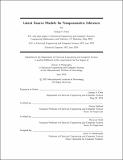| dc.contributor.advisor | Polina Golland and Devavrat Shah. | en_US |
| dc.contributor.author | Chen, George H | en_US |
| dc.contributor.other | Massachusetts Institute of Technology. Department of Electrical Engineering and Computer Science. | en_US |
| dc.date.accessioned | 2015-11-09T19:12:14Z | |
| dc.date.available | 2015-11-09T19:12:14Z | |
| dc.date.copyright | 2015 | en_US |
| dc.date.issued | 2015 | en_US |
| dc.identifier.uri | http://hdl.handle.net/1721.1/99774 | |
| dc.description | Thesis: Ph. D., Massachusetts Institute of Technology, Department of Electrical Engineering and Computer Science, 2015. | en_US |
| dc.description | This electronic version was submitted by the student author. The certified thesis is available in the Institute Archives and Special Collections. | en_US |
| dc.description | Cataloged from student-submitted PDF version of thesis. | en_US |
| dc.description | Includes bibliographical references (pages 95-101). | en_US |
| dc.description.abstract | Nearest-neighbor inference methods have been widely and successfully used in numerous applications such as forecasting which news topics will go viral, recommending products to people in online stores, and delineating objects in images by looking at image patches. However, there is little theoretical understanding of when, why, and how well these nonparametric inference methods work in terms of key problem-specific quantities relevant to practitioners. This thesis bridges the gap between theory and practice for these methods in the three specific case studies of time series classification, online collaborative filtering, and patch-based image segmentation. To do so, for each of these problems, we prescribe a probabilistic model in which the data appear generated from unknown "latent sources" that capture salient structure in the problem. These latent source models naturally lead to nearest-neighbor or nearest-neighbor-like inference methods similar to ones already used in practice. We derive theoretical performance guarantees for these methods, relating inference quality to the amount of training data available and problems-specific structure modeled by the latent sources. | en_US |
| dc.description.statementofresponsibility | by George H. Chen. | en_US |
| dc.format.extent | 101 pages | en_US |
| dc.language.iso | eng | en_US |
| dc.publisher | Massachusetts Institute of Technology | en_US |
| dc.rights | M.I.T. theses are protected by copyright. They may be viewed from this source for any purpose, but reproduction or distribution in any format is prohibited without written permission. See provided URL for inquiries about permission. | en_US |
| dc.rights.uri | http://dspace.mit.edu/handle/1721.1/7582 | en_US |
| dc.subject | Electrical Engineering and Computer Science. | en_US |
| dc.title | Latent source models for nonparametric inference | en_US |
| dc.type | Thesis | en_US |
| dc.description.degree | Ph. D. | en_US |
| dc.contributor.department | Massachusetts Institute of Technology. Department of Electrical Engineering and Computer Science | |
| dc.identifier.oclc | 927307235 | en_US |
